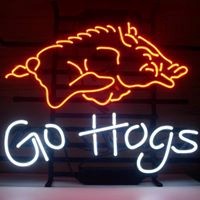Traveling Lecturer: On the Trail of the Wild Hog
Traveling Lecturer: On the Trail of the Wild Hog
Volker J. Sorger, The George Washington University, USA
They call them the fly-over states. The middle of the country (US that is). But, that such a statement is clearly wrongly placed, I experienced first hand.
Being invited by the Laserbacks, Uni. Arkansas (UA) optics student chapter was a great pleasure and honor (top, Fig. 1). Meeting the students we discussed how optical resonances of metallic nanostructures can be understood and improved. It is intriguing to see, how such a ‘simple’ structure of metallic strips in fact is rather complex: first there is the question of optical coupling from the far field excitation to the near field. Such coupling of course is structure and resonance dependent (Mie or antenna theory, depending on the wavelength-to-particle ratio). Then, the particular device we discussed had consisted of multiple coupled cavities making the system more complex. We did come to a conclusion at the end which, I believe, will help this student’s project go move along.

Figure 1. (top) Arkansas Laserback optics chapter logo. (bottom) Mascot of AU – a wild hog at the ‘Powerhouse’ restaurant.
Another, non scientific, aspect I positively recognized at UA, was that underrepresented groups in STEM, here female students, had a long history here. After our meetings, discussions and dinner at the ‘Powerhouse’, I learned about the mascot of UA being a wild boar (bottom, Fig. 1), which reminded me of my youth growing up in the German countryside and hearing the hogs at night. Then, I turned in for the night at the Inn at Carnall Hall, an on-campus establishment of fine quality. What was interesting about it was that this very building used to be a dormitory for female students in the 19th century. The building was named after distinguished Associate Professor of English and Modern languages, Miss Ella Howison Carnall, the first female faculty member at the UA, where she taught from 1881-1884. She was recognized both for her excellence as a professor and for her example as a role model for young women. Such early engagement of visionary leaders at this time of age should remind us that possibility for equality. Let optical science and engineering be a beacon for it.
